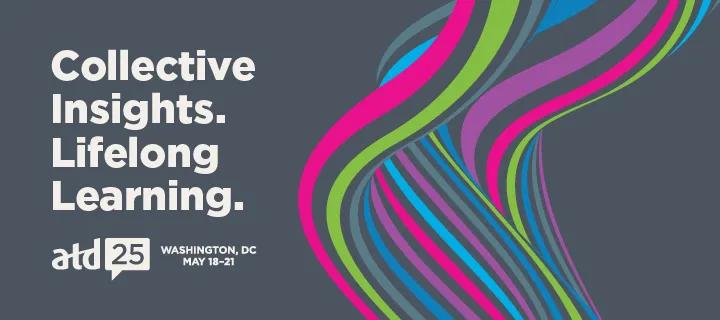ATD Blog
Stagecraft for Trainers: Show Up, Stand Out, Spark Connection
A practical and inspiring guide to delivering unforgettable conference sessions by treating your talk like a performance and your audience like the hero.
Thu May 15 2025

Being a trainer is the best role I’ve ever played – no auditions, just real impact.
Before I ever trained teams or keynoted at conferences, I studied speech communication and performance. I’ve always seen presentations as more than information-sharing; they’re a form of connection. And to truly connect with your audience, you need to feel confident, grounded, and free on stage.
That freedom? It comes from preparation.
Scene 1: Learn It So You Can Leave It
I used to think memorization was the goal. But when I relied only on memorized lines, they vanished the second someone reacted—or didn’t.
True preparation means you’ve learned your material so well that you’re no longer clinging to it. For me, that starts with repetition. I rehearse everywhere: the shower, the car, the checkout line. Once the words are in my bones, I play.
I experiment with pace, tone, and emphasis. I deliver it fast, slow, silly, serious. That playful practice helps me internalize the talk, so I can respond to the room in real time.
Memorization is the first step. But mastery? That’s when you know it well enough to let it go.
Scene 2: Perform, Don’t Just Present
To present is to send something out. But to perform is to deliver it with the intention of moving your audience. That’s the shift—from simply sharing content to creating an experience.
This starts by flipping your perspective. Instead of asking, “What does my slide say?” ask, “What do I want my audience to feel?”
Each segment of your talk becomes a moment of connection. A chance to inspire, challenge, or delight. Maybe you want them to laugh. Maybe you want them to reflect.
This mindset shift turns your talk into a shared journey—one where the audience isn’t just watching you, they’re with you.
When you design your delivery with their experience in mind, you make them the hero of the story.
Scene 3: Embrace the Improv—That’s Where the Magic Lives
What if nothing goes to plan?
What if the tech fails? What if the slides freeze? What if the audience doesn’t respond the way you expected?
Here’s my advice: Expect it, and prepare anyway.
When you’ve truly learned your material—not just what you’ll say, but what you want your audience to feel—you can flex with whatever’s in front of you. You’re grounded in your message, not your media.
It’s like ordering your favorite iced latte in a new coffee shop. Maybe the roast is different. Maybe they use oat milk instead of almond. And somehow you still love it because what matters most isn’t the exact recipe but the experience.
Rehearsal gives you the freedom to improvise. To pivot. To make that moment, unexpected as it may be, memorable.
That’s where real connection happens. And where the best stories begin.
Scene 4: Nerves Are Normal – Let Presence Lead
Nerves? Oh, we all have ’em.
That’s why I don’t just plan my content; I plan my presence. I arrive a day ahead whenever I can. I walk the room, stand on the stage, and introduce myself to the space. I wear what I’ll wear during the talk. Yes, a solo dress rehearsal! The more familiar it all feels, the calmer I am when it counts.
I also prepare my body as well as my mind. I work out, stretch, run in place, and warm up my voice, just like an actor before curtain call. I’m combining energy and focus, turning those inevitable nerves into fuel.
In one of my favorite books, Make a Scene: Storytelling, Stage Presence, and the Art of Being Unforgettable in Every Spotlight, Mike Ganino puts it perfectly: the goal isn’t to fight stage fright, it’s to transform it into presence.
Audiences don’t expect perfection. They want connection. They want to learn from real people who’ve been through it, not polished presenters who seem out of touch.
On the day of your session, arrive early with intention. Support the presenter before you. Set up with care. Chat with attendees as they arrive. Play music. Enjoy the energy. These people showed up, and they’re hoping you show up as your real self, too.
And one last thing: honor the clock. End on time. Pack up fast. Leave the stage ready for the next speaker, just as you found it.
Scene 5: It’s Not About You, It’s About the Moment You Create
Here’s the truth: The stage isn’t a spotlight. It’s a bridge between you and your audience. Your job isn’t just to impress the audience but to reach them.
One of the most powerful ways to do that is through authentic storytelling. As Ganino explains, the goal isn’t to rely on tired anecdotes; it’s to craft transformational narratives that invite your audience to see the world differently. The best presentations don’t feel like lectures. They feel like conversations.
That kind of impact doesn’t happen by accident. It happens when you plan every moment with your audience’s experience in mind.
And that brings me to one of my guiding questions. This is the question I ask myself throughout my design and delivery process: What did I just say or do that I could have let my audience say or do instead?
That’s how you make the audience the hero of the story. That’s how you ensure they feel seen, involved, and changed by what you share. Because in the end, this isn’t about performing for them. It’s about connecting with them.
Training is theater for the business world. We perform. We connect. And if we’re lucky, we get standing ovations in the form of changed minds.

